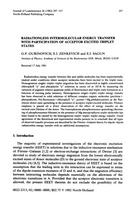| dc.contributor.author | Gurinovich, G. P. | en |
| dc.contributor.author | Zenkevich, E. I. | en |
| dc.contributor.author | Sagun, E. I. | en |
| dc.date.accessioned | 2017-05-18T13:04:58Z | |
| dc.date.available | 2017-05-18T13:04:58Z | |
| dc.date.issued | 1982 | |
| dc.identifier.citation | Gurinovich, G. P. Radiationless intermolecular energy transfer with participation of acceptor excited triplet states / G. P. Gurinovich, E. I. Zenkevich, E. I. Sagun // Journal of Luminescence. – 1982. – Vol. 26, № 3. – P. 297-317. | en |
| dc.identifier.uri | https://rep.bntu.by/handle/data/30006 | |
| dc.description.abstract | Radiationless energy transfer between like and unlike molecules has been experimentally studied under conditions where acceptor molecules have been excited to the triplet state. Homogeneous singlet—triplet—triplet migration has been discovered in higbly concentrated chlorophyll “a” and pheophytin “a” solutions in castor oil at 183 K by measuring the variation of pigment relative quantum yields of fluorescence and triplet state formation as a function of exciting pulse intensity. Heterogeneous singlet—triplet—triplet energy transfer has been observed in solid solutions of different complex organic molecules (perylene +phenanthrene, Na-fluorescein +chlorophyll “a”, pyrene+ Mg-phthalocyanine) as the fluorescent donor state quenching in the presence of acceptor triplet-excited molecules. Primary emphasis is placed on a direct observation of the effect of energy transfer on the excited-state lifetime of the donor. The benzophenone phosphorescence quenching (shortening of phosphorescence lifetime) in the presence of Mg-mesoporphyrin triplet molecules has been found to be caused by the heterogeneous triplet—triplet—triplet energy transfer. Good agreement of the theoretical and experimental results permits us to conclude that all types of observed transfer processes are described by the Förster—Galanin theory for dipole—dipole radiationless energy transfer with no additional assumptions. | en |
| dc.language.iso | en_US | en |
| dc.title | Radiationless intermolecular energy transfer with participation of acceptor excited triplet states | en |
| dc.type | Article | ru |
| dc.identifier.doi | 10.1016/0022-2313(82)90057-6 | |

